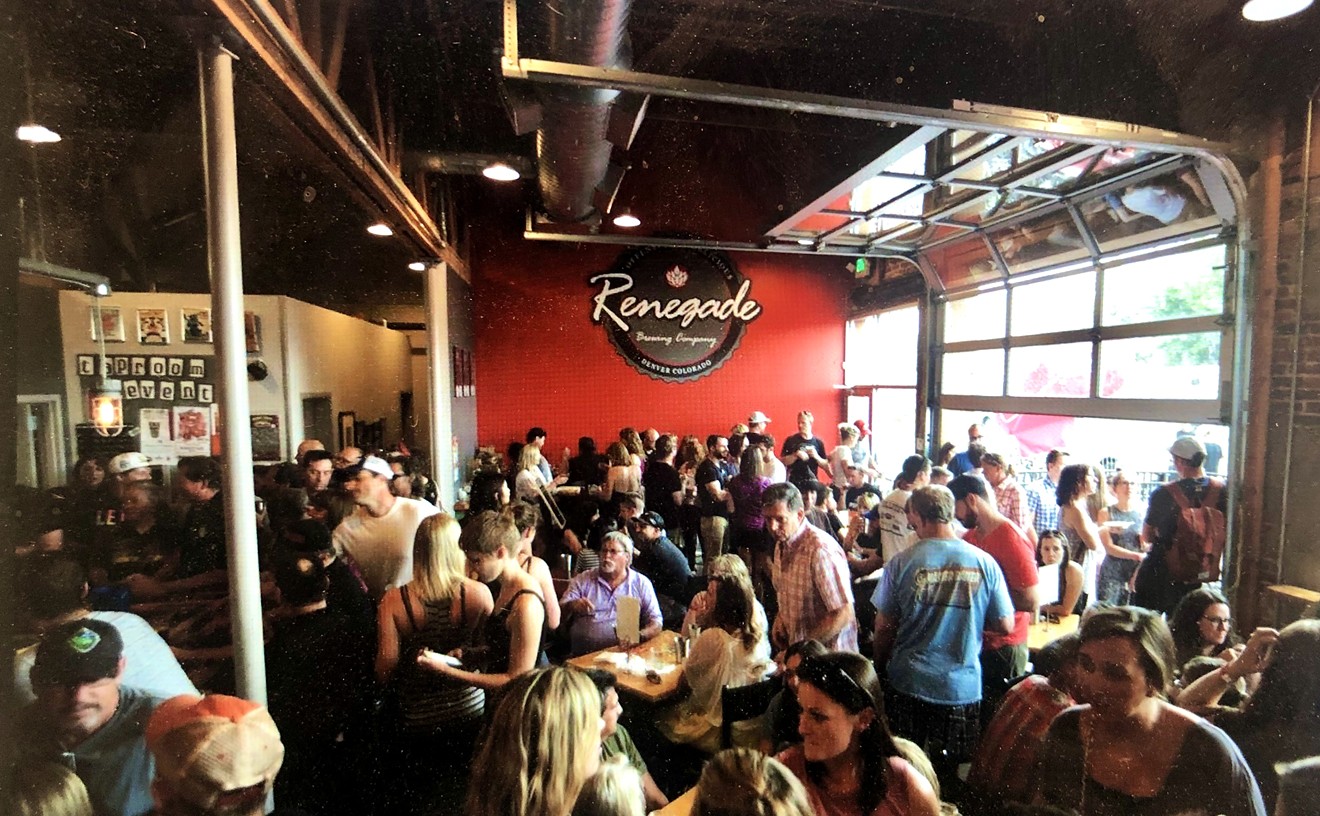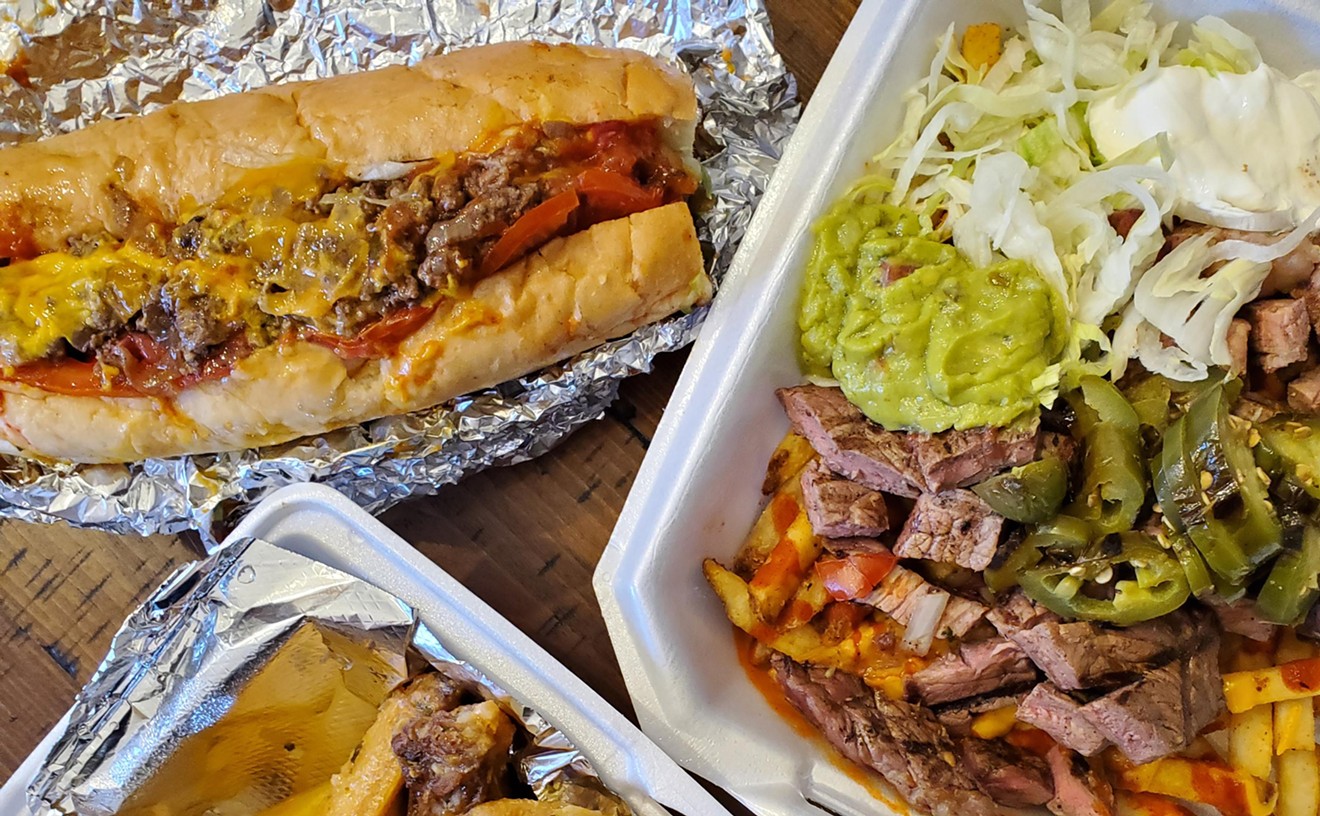A man could cause trouble in a kitchen like this. A man -- a smart man -- could train an army of ethno- specific pizza men and wing-dunkers, send out flying squads of delivery drivers to the far corners of Capitol Hill and downtown, spreading the joy of Buffalo pizza and Buffalo chicken wings to the increasingly urban population. A man with money enough and patience enough and the skills of an Upstate native galley kid could make his mark on the New West with this much space, this much equipment and the kind of fearless confidence it must have taken to sink gobs of dead presidents into creating this kitchen before knowing whether there'd be enough demand to earn that money back.
But then, that's the story of the restaurant business. And when Kris Ferreri opened Luciano's six months ago, he was pretty sure -- no, totally sure -- that his version would have a happy ending.
Buffalo-born and Buffalo-bred, with family ties that go back to when the first Ferreri (Kris's great-grandfather Luciano, after whom he named the restaurant) settled in the area in the early 1900s, Kris spent much of his life steeped in the near-mythological Upstate pizza-and-wing scene. For more than two decades, he lived surrounded by chicken-wing joints, bathed (like any good Buffalonian, metaphorically speaking) in the hot sauce and sweet reds of that two-note food town. Anyone who's spent any time in Buffalo knows exactly how seriously that city takes its wings. It's nearly an unwritten ordinance that every restaurant must serve them, and that all of those restaurants must pay a certain (though sometimes backhanded) deference to those served at the Anchor Bar on Main, where the fried chicken wing was invented.
In Buffalo, the chicken wing inspires the same sort of fanatical devotion and sectarian violence that, in saner places, is reserved for religion, politics or sports teams. England has its soccer hooligans cracking each other's skulls with lead pipes and batteries over loyalties split between Arsenal and Manchester United. The Irish blow up each other's cars over questions of theology, political occupation and the rights of little redheaded girls in orange dresses to walk through certain Belfast neighborhoods. In Buffalo, drunken old coots and UB hat boys get in street-corner brawls and punch out each other's teeth arguing over who fries a chicken wing better, La Nova or Jim's, Duff's or the Anchor.
But the truth (and I can only reveal this now because I am thousands of miles removed from the streets of Buffalo, and it's unlikely that any Buffalonians are going to make the drive out here to Denver to punch me in the nose, because all of their cars will be frozen in the ice for another three months or so) is that none of those chicken wings are any better than the others, because they're all cooked the same way. You take a fistful of skin-on, gooey, raw, dismembered chicken wings and legs out of a blood-slick plastic bag, toss them into an over-hot fryer for twelve minutes, remove them, give them a shake, dump them into a steel bowl, add a long pour of Frank's RedHot and a short pour of melted butter (or even better, butter substitute), toss and serve. That's it -- the trade secret. Properly arranged ten to an order, they should come with a few sticks of celery and some blue-cheese dressing for dipping, even if purists scorn the use of both. There's no question of doing a chicken wing better or worse than any other restaurant, just the question of whether you do it right or wrong.
In Buffalo, it's a point of pride that while the fried chicken wing's fame has flown far beyond the city limits, no one outside the city can make an order exactly right. But Ferreri does. When he moved to Denver, he brought with him an expertise that comes only from spending years in the home of the chicken wing, as well as a very specific regional pizza. He knows his stuff, and it shows.
Like any other ethnic restaurant -- and cooking la basse cuisine de Buffalo makes Luciano's just as much an ethnic restaurant as any Ethiopian, Cajun, Vietnamese or French joint -- Luciano's must first please its constituency, in this case that small ex-pat crowd of I-90-corridor New Yorkers who, like me, got wise and fled the muggy summers and brutal winters along Lake Ontario for somewhere -- anywhere -- better. And any ex-pat who sees one of Ferreri's to-go orders tucked into a butcher-paper-lined cardboard box would know that Luciano's is the real deal. Wings packaged in Styrofoam (a sin all too common among Denver's wing pretenders) melt the box and, consequently, taste like Styrofoam. Wings packaged in foil pick up a slight metallic aftertaste through the heat and the acids in the hot sauce, and that's no good, either. Packaging the wings in paper and cardboard both protects the flavor and creates a smell that's instantly recognizable to any former Upstater: searing hot oil, hot sauce and hot, damp cardboard mingling into a perfume that's uniquely Buffalonian.
But while Luciano's has the process down, it stumbles several times along the way. First, the wings are dramatically overpriced at ten for seven bucks. I understand that Ferreri has to make up for all the green spent on those pretty fryers and big-deck ovens, and I get that seven dollars a dozen may be the going rate back in Buffalo, but here, where it could be argued that a Buffalo chicken wing is nothing more than a regional delicacy already served (incorrectly, most of the time) in every bar in town, five bucks would be reasonable. And four would be better. Second, the wings are small. Wings, like shrimp, are graded by how many you get raw to a pound. And Luciano's must get a lot to the pound, because the kitchen's using a very scrawny wing.
Worse, though, is the fact that the heat of these wings is inconsistent. I'm a traditionalist who trained in the Way of the Wing at some of Buffalo's hottest houses, cooking at Gabriel's Gate, at Bob and John's La Hacienda and elsewhere when I was between white-jacket gigs. With monkish, slavish devotion, I tossed hundreds of pounds of wings a night, developing forearms like Popeye and having my sinuses cauterized by the clouds of hot oil and Frank's that rose in a corrosive steam from the bowls. I learned through experience that mild means a long shot of butter out of the jug and a lace of Frank's from the speed-pourer, just enough to give the sauce the correct red-gold color. Medium is a fifty-fifty mix. Hot is a long pour of Frank's with a dash of butter for lubrication. And super hot? Well, every wingman in Buffalo has his own custom mix of cruel, brutal spices that can be added to the final toss in order to punish those who dare order anything hotter than hot. Crushed chile flakes. Capsicum powder. Dynamite. Whatever.
At Luciano's, hot might be downright mild one night; on another, mild's a pointless tongue-scorcher. While there's nothing wrong with having your wings running hot, the degree should be something you can count on. But you can't at Luciano's, which confuses those wing fans who might otherwise become regulars. And a place like this needs regulars to support it while word spreads to those who don't know how lucky they are to have a real Buffalo wing joint in the neighborhood. Even one that serves small, overpriced wings.
Luciano's doesn't just do Buffalo wings, though. In addition to the standard barbecue, there's a fiery Jamaican jerk and a honey-mustard char-pit wing. And the kitchen puts those ovens to use for another regional derivation: the Buffalo pizza.
Pizza-making is a weird art, with the style and fashion of the pie degrading in direct relationship to how far you travel from ground zero. The best pizza in the universe -- the archetypal New York thin-crust -- comes from the storefront pie shops and slice-a-terias of Brooklyn and the Bronx. The farther you go from this cradle of pizza perfection, the less recognizable and the more derivative the pies become. In Camden, New Jersey -- just spitting distance from the boroughs -- the only difference is the sauce, which is slightly more herby. A bit farther away, in Philadelphia, you start getting street-corner joints that refer to themselves as "New York-style" pizzerias but produce a slice pie that's marginally thicker in the crust and somewhat less oily, depending on how long it's been sitting. For a layman, such slight variations are meaningless, but for a true connoisseur, a quarter-inch can make a big difference.
Buffalo is roughly 450 miles removed from the greasy center of the pizza-making universe, and its pizzas are barely recognizable knockoffs of New York thin-crust. Although they're described in all manner of unflattering terms by those who didn't grow up eating them, they definitely have their fans, and Ferreri has brought a pitch-perfect Buffalo pie to Denver. His pizzas are technically thin-crust, but they're two, maybe three times as thick as a paper-thin New Yorker, and also dense, chewy, blistered and stiff-bottomed from direct contact with the stone floor of the pizza oven. To my tastebuds, the sauce is excellent -- medium-sweet and thick, with little more than squashed tomatoes and a touch of salt for flavor. For a New York pie purist, though, it would be too thick, and for Denver -- where it's tough to find a sauce that hasn't been gussied up with herbs and spices and red-pepper flakes -- it's too bland.
The ingredients are all good quality and include some odd, pure Upstate one-offs like candy-sweet maraschino cherries on the Hawaiian pie and feta on the Greek; there's even a chicken-wing pizza made with stripped white meat, wing sauce rather than red, and a lacing of blue-cheese dressing. Ferreri also offers breakfast pizza, taco pizza, pepperoni pizza with thick chunks of meat that cup up under the heat of the oven and char around the edges, and a straight, old-timey Eye-Tie white with Romano, mozz and Fontinella surrounding the fresh tommies, scorched onions and anchovies.
No matter what's on top of the pies, they're all based on the rigorous replication of a regional style that may seem odd to those who don't understand that in one small, frozen corner of the world -- Buffalo, New York-- this is simply the way pizza is made. To those who don't understand, the pizzas taste like the up-from-frozen pies served in high school cafeterias all across the country, like Tombstone from the freezer. More than anything, they just taste wrong.
And, sadly, the fact that Ferreri's actually doing it right doesn't fill chairs. At dinner on a Sunday, the wife and I are alone in the pleasant dining room -- one half Pizzeria Uno chain-restaurant sterility, one half neighborhood rustic, and (excepting the sump-and-disinfectant smell coming from the bathrooms just past the TV) perfectly keyed to the crowds that Ferreri expected to swamp his paean to the Buffalo pizza-and-wing joints of his youth. The room is so clean and quiet that we feel more like the first customers than the only customers on a night six months after Luciano's grand opening.
Back in the kitchen, the hood fans are roaring. The oil is hot. There's dough in the proofing boxes, back stock in the lowboys, and a rainbow of ingredients in the island of cold tables that sit smack in the middle of all that space. It's all waiting for people to realize that Luciano's offers real Buffalo cuisine. But the awful truth may be that real isn't enough here, and that Buffalo cuisine is better left to the frozen latitudes where it was born.










